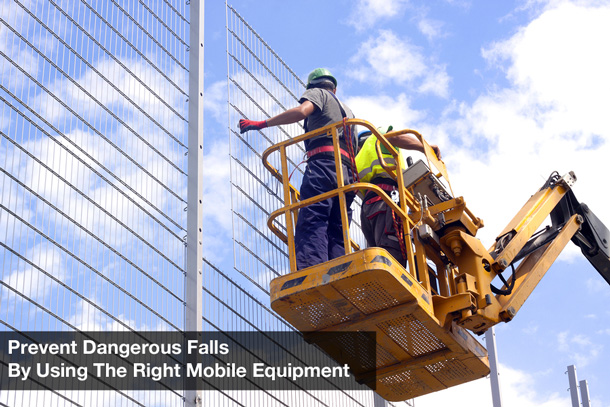Prevent Dangerous Falls By Using The Right Mobile Equipment

Complex fall protection situations arise all the time. Workers find themselves in scenarios where they need to have fall protection and a personal fall arrest system (PFAS) seems to be the only solution available, yet there is no suitable anchor point. This always comes up at the last minute; work is in full-swing, a deadline is looming, and somehow, someway, this crazy fall protection requirement sneaked its way up on everybody.
What we've got here is failure to plan. Yet, that doesn't change the fact that we still need a solution given the current conditions. Time and again, when difficult fall-protection situations arise, companies will ask me, "Can't we just tie-off to that lift?"
And, as in so many situations, the answer is a solid, resounding, "It depends."
If you notice, in all boom lifts there are angles welded into the rails either in front of or behind the users. These also exist in some newer scissor lifts. Alternatively, some scissor lifts have rings built into the floor of the machine. These are all engineered anchor points, built with the intention of being used as part of a PFAS. However, that does not mean that they can be used in all situations. In fact, according to the manufacturer there is only one situation in which they can be used: when a user has both feet on the floor of the basket.
Period.
The anchor points in lifts are designed to keep users in the basket in the event of a collision, sudden movement, or other situations that can result in ejection. They are not designed to be used so that workers can climb onto the rails, ladders, or other elevation devices, nor are they designed to be used as an anchor for anybody working outside the basket. The reason being that most lift manufacturers have not tested their lifts in situations where such forces as those applied in a fall – from an object outside of the basket – are exerted on the machine. Without testing, there is no way manufacturers will approve this type of use and OSHA will always defer to the manufacturer. In addition, the tipping point of the machine is figured based on workers being IN the basket. Once you begin to elevate yourself, those calculations no longer apply.
This situation occurs often in existing buildings that are being renovated or that are having maintenance work done that can only be reached via a lift. It is common for there to be many obstructions, such as piping, duct work, or even the roof joists themselves depending on the size of the basket you are in. But there are solutions. Sometimes it might be using a mobile work platform that can get closer to a working level and other times it might require lift attachments. Whatever the solution, it's not going to be determined by the guy that's just trying to get his job done with a boss breathing down his neck. As with all fall protection, it needs to be discussed and determined in the planning stages of the job.



